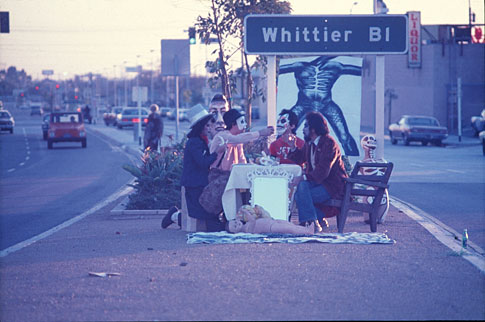Los Angeles County Museum of Art ,
Sep 04, 2011 - Dec 04, 2011
Los Angeles, CA, USA
Asco: Elite of the Obscure
by Mariola Alvarez
These days catalogues are less a take home reminder of an exhibition and more of a self-contained archive, scholarly tome or a full-blooded vindication. In the case of the Asco catalogue, it is all three, as well as a guide to understanding works that within the museum installation remained a bit of a sphinx. ASCO: Elite of the Obscure, A Retrospective, 1972-1987 serves as the title for both the exhibition and catalogue, curated and edited by C. Ondine Chavoya and Rita Gonzalez, and organized by the Los Angeles County Museum of Art (September 4, 2011 to December 4, 2011) and the Williams College Museum of Art (February 4 to July 29, 2012). Based in Los Angeles, Asco was an art group that included the artists, Harry Gamboa, Jr., Gronk, Willie F. Herrón III, and Patssi Valdez. Yet to receive a retrospective exhibition at a major museum, nor a scholarly monographic treatment, Asco deserves the accolade offered them by Chavoya and Gonzalez. The opening of the exhibition in Los Angeles marked a major coming out for the group and for Chicano artists in a city where they have often been glossed over within the historical marking of L.A. art and marginalized within the city’s exhibition and curatorial practices. The exhibition formed part of a much larger initiative by the Getty Museum called Pacific Standard Time: Art in L.A. 1945-1980, which funded museums and galleries across the Southern California region to research and exhibit works produced in the area. As a result, ASCO: Elite of the Obscure became one node in the network history of L.A. art being told in the present moment. This historical re-evaluation places Asco now within the canon of contemporary art as both representative of L.A. art and Latino art, a relationship that was not always tenable or friendly. The story of Asco is the story of Los Angeles, and thus its inclusion in Pacific Standard Time writes the history of art from California as one that included discrimination against artists and the racial mapping of the city. Asco most famously countered these exclusionary practices with their Spray Paint LACMA when in 1972 they spray painted their individual names on the walls of the museum and made themselves present. The richness and complexity of Asco’s inter-media art production, in evidence at the exhibition and in the catalogue, was due to its intimate and specific engagement with the city of Los Angeles. The members of Asco became friends in the 1960s when they were in high school in East Los Angeles. Their neighborhood often served as a setting for their performances, but not just as a backdrop, instead the neighborhood was a central player in the formation of their ideas and practices. Any discussion of their work must engage with the history of place and how geography operates to organize and set apart groups of people. The East Side of Los Angeles was and remains a low income and Hispanic neighborhood, in stark contrast to the West Side, which houses LACMA and the Getty Museum and the art scene most often considered central to the making of contemporary L.A. art. Asco’s practice reacted to this geographical division and the resultant segregation of communities in the arts, as much as it also critiqued local practices of Chicano representation, especially the tradition of figurative murals and object-based production. The limitations of the exhibition especially could be found here in the impossibility to make visible the histories of Los Angeles for viewers unfamiliar with the literal and symbolic geography of the city. Though the exhibition included wall texts to introduce the stages of Asco’s art and its "numerous conceptual underpinnings," the neat organization and display of the works often transformed them into pure fine art photography. I would have liked to see more of the messiness and bad taste at the heart of Asco’s practice reflected in the presentation of the LACMA galleries. Chavoya and Gonzalez clearly decided to use the catalogue as the place to consider multiple interpretative frames for Asco’s conceptual art and performances, rather than fill the galleries with excessive explanatory wall texts.
|













